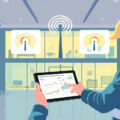RF (Radio Frequency) technology has emerged as a pivotal component in modern communication and connectivity. Its applications span various sectors, including healthcare, logistics, and safety, reflecting its versatility and transformative power. In this article, we will explore RF technology’s fundamental principles, its expansive applications, and its impact on today’s world.

Understanding RF Technology
At its core, RF technology encompasses the use of electromagnetic waves within the frequency range of around 3 kHz to 300 GHz. These waves carry signals without needing a physical medium, enabling efficient wireless communication. RF technology’s backbone lies in its ability to transmit data over distances without significant interference, making it ideal for myriad applications, particularly in sectors where real-time communication is critical.
Key Components of RF Communication
- Transmitters and Receivers: Transmitters convert audio or data signals into radio waves, while receivers do the reverse, retrieving and decoding these waves back into usable information.
- Antennas: These are crucial for broadcasting and receiving radio signals. The design and placement of antennas significantly influence the quality and range of the RF communication.
- Modulation Techniques: Various modulation methods (like AM, FM, and digital modulation) are utilized to encode information onto the carrier wave, optimizing the transmission for clarity and efficiency.
Applications of RF Technology
RF technology has found a multitude of uses across different industries. Here are a few noteworthy applications:
1. Healthcare and Safety
RF technology is increasingly employed in healthcare settings to enhance safety and improve operational efficiency. For instance, companies like RF Technologies offer solutions like Code Alert® and Help Alert®, both designed to enhance patient safety and staff protection. These systems enable real-time communication and tracking, crucial for responding to emergencies and ensuring seamless operations in hospitals and senior living facilities.
Key Innovations:
- Wearable Enabled Systems: Utilizing RF for alert systems, like fall detection and infant security, which significantly mitigate risks in vulnerable populations.
- Staff Protection Solutions: Devices that allow staff to summon help instantly, leveraging RF technology to provide a secure working environment.
2. Logistics and Asset Tracking
In logistics, RF technology facilitates asset management and tracking, drastically improving operational efficiency. Technologies such as RFID (Radio Frequency Identification) enable the tracking of goods in real-time, ensuring inventory accuracy and reducing losses.
Benefits:
- Enhanced Efficiency: Automated systems streamline operations, from inventory checks to supply chain management.
- Cost-Effectiveness: Reduced paperwork and manual labor translate to lower operational costs.
3. Drive-Thru and Fast Food Operations
RF technology is also instrumental in the fast food industry, particularly in drive-thru operations. Companies like RF Technologies provide drive-thru systems that enhance communication between customers and staff, improving service efficiency.
Innovations:
- Drive-Thru Communication Systems: RF-enabled systems that facilitate quick order taking and customer service, thus reducing wait times and improving customer experience.
- Integration with Digital Technologies: Combining RF with digital displays and kiosks for a more streamlined customer interaction.
The Future of RF Technology
As RF technology continues to evolve, its potential applications are expanding rapidly. With advancements in signal processing, miniaturization of components, and the integration of AI, the future of RF technology looks promising. Innovations such as 5G networks are set to propel RF technology into new realms of connectivity, providing faster and more reliable communications that support the growing demands of data in today’s digital age.
Conclusion
RF technology is not just a thread in the fabric of modern communication; it weaves through various sectors, enhancing safety, efficiency, and connectivity. As society continues to innovate, the role of RF technology will undoubtedly become even more integral, paving the way for smarter solutions and a more connected world. Understanding and harnessing RF technology is crucial for leveraging its full potential in driving future advancements across industries.



